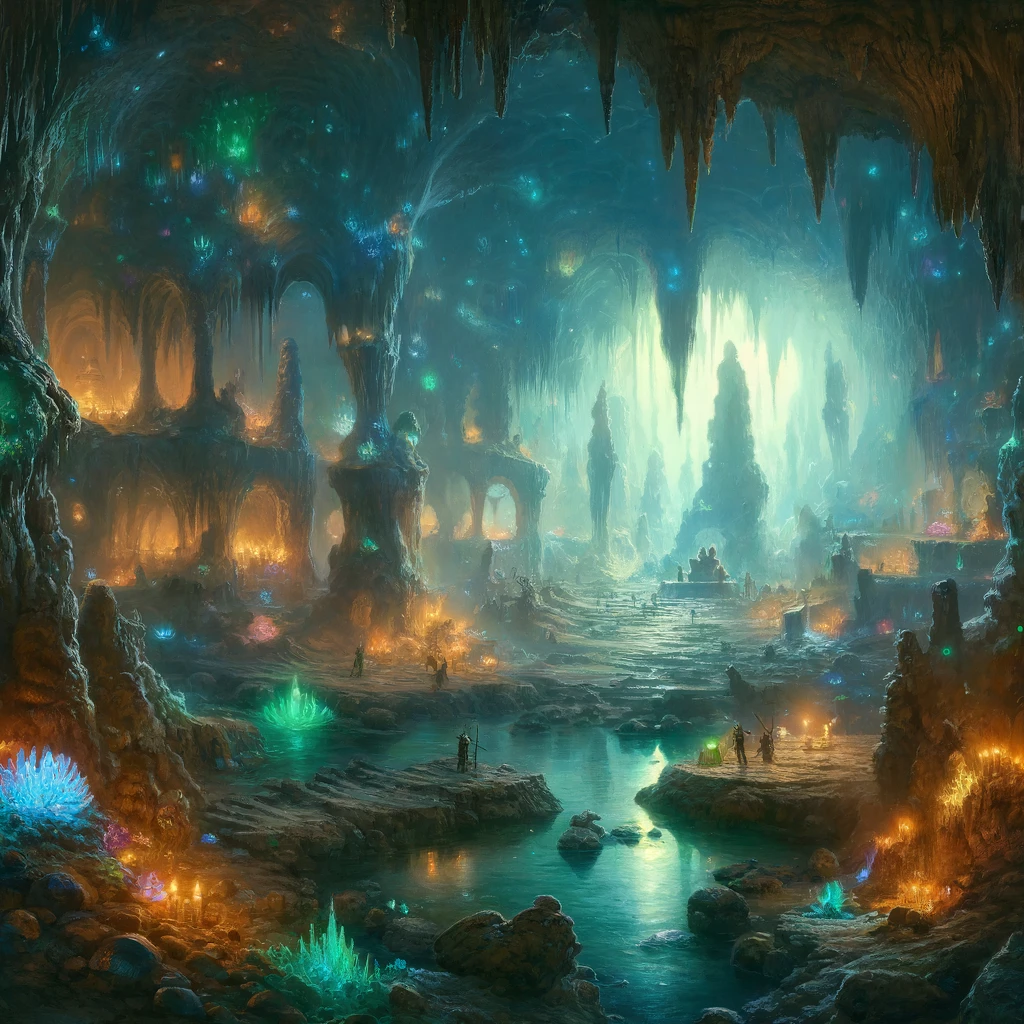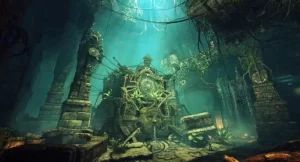
Underground Caves
Prepare to embark on a subterranean odyssey in these underground fantasy locales - through the awe-inspiring, labyrinthine realms of caves and caverns! Sculpted by the relentless hands of Mother Nature herself, these darkened sanctuaries possess features that could only be described as dramatically captivating.
Far from mere holes in the earth, these enigmatic mazes frequently serve as the exhilarating entryways to dungeons teeming with mystery, danger, and untold treasures!
Hold your breath, for there are three mesmerizing varieties of caves to explore, each offering its own unique allure and hazards. First, venture into the haunting depths of limestone caves, where intricate stalactites and stalagmites create cathedral-like sanctuaries that could make you question the very fabric of reality. Beware-these otherworldly chambers often harbor secrets as ancient as the rocks themselves!
But the adventure doesn't stop there. Dare you brave the sea caves, where the roaring tides and ocean's embrace have carved out hidden grottos? Here, the eternal battle between land and sea manifests in stunning natural galleries. Feel the salt on your skin and hear the haunting calls of distant sirens, as you navigate through these water-kissed labyrinths.
Finally, for those who seek a more incendiary experience, lava caves beckon with the promise of thrills born from the earth's very fury! Walk the hollowed-out remnants of once-molten rock rivers, where the Earth's inner fires have created caverns that glow with a surreal, almost preternatural light.
Each type of cave presents its own unique ecosystem, challenges, and opportunities for daring exploits. So gear up, intrepid explorers, as you prepare to plunge into the bewitching bowels of the Earth. Who knows what magnificent wonders or chilling terrors await you in these complex catacombs? One thing is for sure: this is a journey that will ignite your soul and challenge every fiber of your being!
Limestone Caves
Limestone caves are the most prevalent type, a fact that should come as no surprise. They're primarily located in regions where the bedrock is dominated by vast expanses of limestone. However, it's not just limestone that gets all the action; dolomite and marble terrains can also serve as fertile grounds for these natural wonders to form.
The birth of a limestone cave is a tale of water's persistent, erosive power. Water seeps through rock, gradually eroding it over time. But it's not just any water; rainwater plays a starring role. As it absorbs carbon dioxide from the atmosphere, it transforms into a mild form of carbonic acid-a liquid that rapidly dissolves limestone.
As this mildly acidic water percolates through the Earth, it incrementally enlarges its passageways. With each droplet, the limestone cave expands, becoming an ever-more complex maze. And yet, the cave's growth isn't a straightforward process. Variations in the water table, triggered by events like droughts or floods, can either accelerate or decelerate the flow of water through these subterranean corridors.
Intriguingly, if the water table drops, the narrative takes a dramatic turn. Passages that were once aquatic domains are now arid, air-filled spaces. These dry sanctuaries are like time capsules, holding the stories of creatures that have sought shelter within them since the dawn of existence. Access to these enigmatic realms is often through inlets or outlets that were once the very conduits for the waters that sculpted them.
Although often tortuously narrow or steep, such openings are the most common entrances to limestone caves. A cave that grows too large may not be able to support the expanse of rock above it, and the ceiling may collapse to form a sinkhole. Such a feature drops precipitously from the surface to the floor of the cave, but can be used as an entrance for characters willing to do a little rope work.
When the water has drained from a limestone cave, it is not uncommon for seepage or even small streams to continue to trickle through it. It is the seeping of small trickles of water that creates many of the spectacular underground rock formations that are familiar to those who have ventured into caves.
The most commonly known cave features are stony pillars known as stalactites (hanging from the ceiling) and stalagmites (growing upward from the floor). As with other cave features, they are created by the slow dripping of water, which evaporates and leaves behind small deposits of minerals. Depending on the types of minerals left behind, these cave features can range in color from a muddy brown to red, or even (in rare cases) a pure crystalline white.
Other types of cave features include draperies, flowstone, and gypsum flowers. Draperies (also referred to as curtains) occur where evaporating water has left a sheet of stone that resembles a ruffled curtain. Flowstone often falls in a series of tiers and resembles flowing sludge.
Gypsum flowers are rare and delicate little structures that can be extremely beautiful. If a cave is subject to continuing water seepage, it is considered a living cave, and these features are slowly growing throughout it.
In fact, it is not unheard of for a cave's features to grow so much that they literally fill in the cave that the same process (of dripping and running water) created in the first place. Features in a living cave glisten and shine when light is cast upon them. They are also very sturdy. Although occasional areas of rubble might obstruct passage, such caves are generally very clean and almost dust-free.
Of course, this is before the cave is entered or used by creatures from the outside world or exposed to air from the surface. Mud is also a very common feature of a living cave. All low areas that are not regularly swept by flowing water contain pools of sticky mud. Depending on the drainage and shape of the area, these mud pools can be quite deep.
A dead cave, on the other hand, is one in which the water no longer flows. The features in a dead cave do not glisten, and in fact grow very weak without the constant humidity to reinforce them. Left without water long enough, a cave's features become very brittle and eventually crumble into dust. A dead cave is much more likely to be choked with rubble than its living counterpart.
A layer of dust often covers everything. If water can be found, it has generally been standing in a pool for centuries. Even so, the water found in such locations is very rarely stagnant-the cold temperatures and lack of sunlight see to that. Some limestone caves are completely filled with water. These caves do not have the features described above, unless those features were created when the cave was filled with air, and it has subsequently filled with water.
In general, the passages in a water-filled cave are smooth and rubble-free. Nonetheless, the water may flow through very narrow openings or tightly winding passages, making it difficult or impossible for a character to travel through.
Sea Caves
Sea caves are formed along current or former coastlines where the erosive action of pounding surf gradually wears an entrance into the bedrock. They are generally much smaller than limestone caves, since the waves disperse their energy quickly as they work their way inward. Sea caves are often partially water-filled. Depending on the changing level of the water, a sea cave might even be completely submerged, its mouth hidden to all observers who are not themselves submerged.
On the other hand, if the water level has fallen or the ground has risen, a sea cave might be discovered in a cliff far above the pounding surf, or even many miles inland if the coast has gradually moved farther out to sea. Sea caves have smooth floors, walls, and ceilings, with none of the spectacular features of their limestone cousins. On the other hand, their often relatively easy access makes them more likely to contain some relic of long-past inhabitants.
Lava Caves
Lava caves are created when the crust of a flowing surface of lava hardens, but the molten lava beneath the crust continues to flow. If the conditions are right, the lava flows away to leave an air-filled space that may reach a considerable size. Lava caves are commonly found in areas of volcanic activity.
They do not contain the features typical of limestone caves. Unless the lava caves are in a region of heavy rainfall or are at a very low elevation, they may well be completely dry. In fact, because of their origins, a great many lava caves have no exits to the outside world. Their existence can only be discovered by chance excavation, or perhaps by accidentally breaking through the crust in an area where it is very thin.
Earthquakes and rockslides can occasionally create underground chambers that are tenuously supported by accumulated rubble. While these underground locations resemble caves, they are not true caves. Occasionally such a chamber may be large enough for a party of characters to enter, but rarely is there much to see.
These locations, however, can make good overnight shelters and may also provide comfortable lairs for any number of potentially hostile animals or monsters. Geological faulting can create cavities in the earth when a large shelf of rock moves and the neighboring rock remains stationary. Such caverns are often completely enclosed, but may be very large.
Geothermal heat is a feature that can be encountered in deep caves of any kind, although it is particularly likely in a lava cave, since the lava itself is a carrier of geothermal heat. Geothermal heat is simply heat energy originating from the unknown reaches deep under the crust of the earth.
This heat can be encountered by underground explorers in a number of ways. The most dramatic, perhaps, is the glowing crimson flow of molten lava. Such melted rock carries heat from the deepest reaches of the earth toward the surface, and retains (and radiates) its heat for a long time. Molten lava has a temperature of approximately 1,800° F, and quickly kills any non-fire resistant creature forced to come into contact with it.
Even in areas where the lava has cooled to a solid crust, it can still be blisteringly hot. A character foolish enough to venture onto such a crust runs the risk of breaking through into the infernal heat below. Steam is another manifestation of geothermal heat that could be encountered by cave explorers.
Although not nearly as hot as lava, steam can nonetheless scald or even kill a creature caught in its intense blast. Steam can arise suddenly in areas of high geothermal activity, whenever water happens to run into some area that is hot enough to quickly vaporize it. Such instant vaporization can create high steam pressures, and cause blasts of steam to erupt far from the actual source of the heat.
A more tolerable instance of geothermal heat is in the form of warm or hot water. Depending on the proximity and intensity of the heat source, the water temperature can range from lukewarm to boiling. Warm or hot air rising through subterranean passages can often be an explorer's first warning that he is approaching a source of geothermal heat. This can actually be a pleasant experience, especially for characters well-chilled by a long expedition through dark and dank chambers.
Read more about caves here: Dungeon and Cavern Cave-ins






